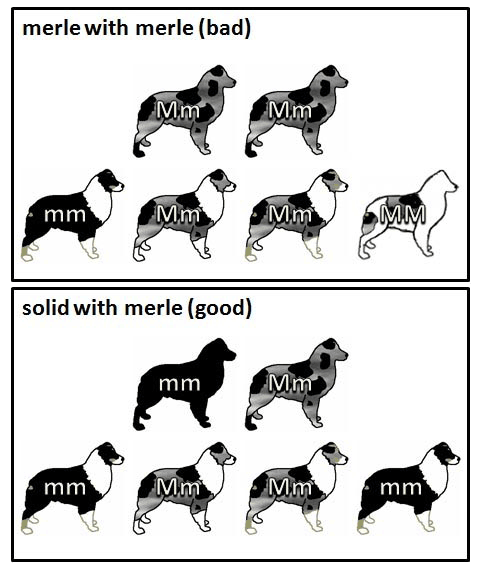I am what is commonly refered to as double merle Aussie, or a Homozygous merle australian shepherd. As you might have guessed, I am blind and deaf. Don;t feel sorry for me, I don’t know any other way as I was born this way. Don’t worry, my condition is not lethal. It is only a minor set-back. In fact, I plan to live a normal life, just like any other dog!
I thought I would share with you some information on what it means when I say I am a double merle. When two merle Australian Shepherds are bred, 25 percent of their puppies have the genetic potential to be blind, deaf, or both blind and deaf. Merle means mottling like the black and white areas of my fur. For a breeder to be “responsible”, a merle colored Aussie should always be bred to a solid colored Aussie. That way the dominant gene cannot win and the puppies don’t get the crummy genetic combo (possibly resulting in deafness and/or blindness).
 Ok, so what in the world does color have to do with vision and hearing in a dog? Well, what happens, is the pigments are related to the development of the eyes and the nerve endings in the ear. Because double merle puppies often have a mostly white head or very little color on their head like me they don’t have the pigments that are tied to the development of the nerve endings in the ears and the eyes for sight. Another thing is our eyes can be really small, or not there at all. Mine are really small, but my ears, well that’s another story. My human mom likes to call me ‘Ears’ sometimes because mine are huge. I am finally growing into them but it has taken a while.
Ok, so what in the world does color have to do with vision and hearing in a dog? Well, what happens, is the pigments are related to the development of the eyes and the nerve endings in the ear. Because double merle puppies often have a mostly white head or very little color on their head like me they don’t have the pigments that are tied to the development of the nerve endings in the ears and the eyes for sight. Another thing is our eyes can be really small, or not there at all. Mine are really small, but my ears, well that’s another story. My human mom likes to call me ‘Ears’ sometimes because mine are huge. I am finally growing into them but it has taken a while.
If you have any questions about double merles or genetics you can e-mail me. I love to get e-mail and will have my humans check it for me so I can help them write a response to you quickly.
Or, if you want more scientific detail on hearing and sight development keep reading, like maybe those of you who are students working on a research paper.
In order to fully understand why a double merle can be deaf due to lack of pigment in the inner ear, we need to understand the basics of how sound is transmitted from the ear to the brain stem. The ear consists of three parts: The external ear, the middle ear and the inner ear. Sound enters through the external ear opening as air vibrations which are funneled through the ear canal. The eardrum then vibrates and transmits the energy of the sound waves to the middle ear. The “bones” of the middle ear, or the hammer, anvil and stirrup act as transformers and convert the vibrations which are then transmitted to the inner ear.
The inner ear consists of three segments: cochlea, vestibule and semicircular canals. The cochlea is coiled like a snail’s shell and is filled with fluid. Within the cochlea is the organ of Corti that contains hair cells which act as receptors. The hair cells convert the mechanical energy to electrical nerve energy which then passes along the cochlear nerve and through the network of nerves to the brain stem.
The inner ear is where the lack of pigment comes into play in causing deafness. In order for the hair cell to convert the mechanical energy into electrical or nervous energy, the hair cell must contain a pigment cell, if it doesn’t the hair cell cannot convert the mechanical energy and the ‘sound’ ends before reaching the brain stem.
The degree of deafness for a dog depends upon much pigment is lacking in the inner ear. Some pigment would allow for partial hearing, and a total lack of pigment would cause total deafness which could occur in one or both ears. Australian Shepherds are not the only breed to be effected by this type of deafness. Any breed with a white or merle hair coat is at risk such as Dalmatians.





